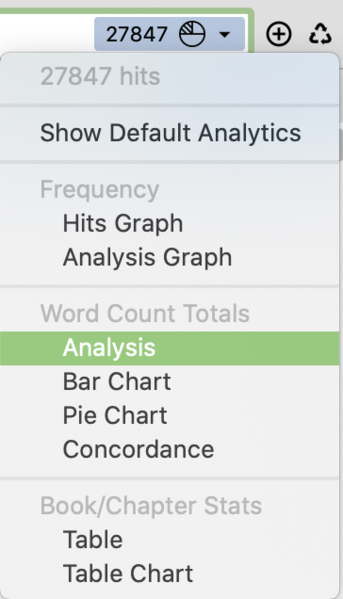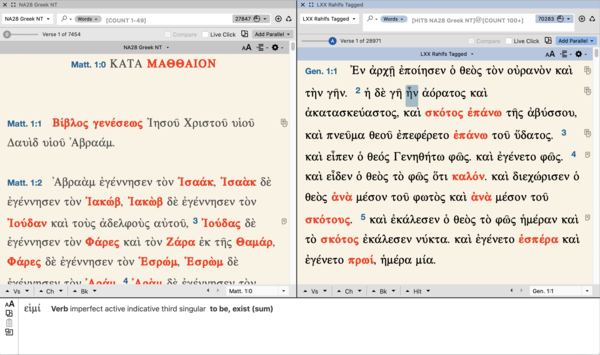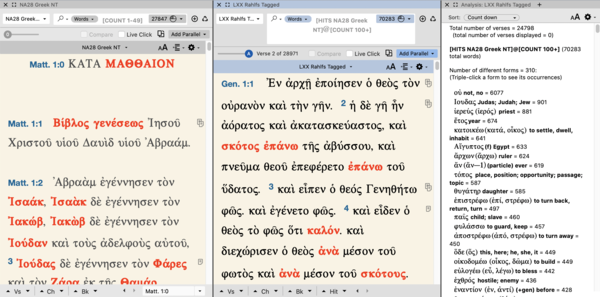 My love of reading Septuagint texts began with a struggle in Greek 2.
My love of reading Septuagint texts began with a struggle in Greek 2.
I aced first-semester Greek. But second semester brought “second aorists,” and those irregular verb forms gave me trouble. (Increased responsibilities at home and at work added to my challenge.)
As Willam D. Mounce notes in his Basics of Biblical Greek Grammar, sometimes a single letter sets apart a second aorist from the imperfect form of the same verb. So, he recommends, “Memorize exactly.”
I did not memorize exactly, and it showed on my first Greek 2 exam, which was full of second aorists to parse. I didn’t bomb the exam, but I did have to work hard the rest of the semester to get my grade back up to my goal. The exam was also enough to get my (and my professor’s) attention. I scheduled a meeting with him—in part, because my motivation to memorize morphology was waning.
“I loved Hebrew,” I told my professor, “but I’m feeling stuck. And I’m not loving what feels like rote memorization.”
He helped me with some motivational techniques, and then asked me about the Septuagint. Had I ever read it?
I wonder how many second aorists it has, I thought.
But the idea of going back to the Hebrew Bible—in Greek!—was enthralling to me.
I had the added motivation I needed. I wasn’t learning Greek just to read the New Testament now. I was learning it to read the Old Testament, too.
But there was one huge hurdle: even after I completed Greek 2, my vocabulary knowledge was no match for all I was encountering in the Septuagint. There are, after all, about four times as many verses in the Septuagint as in the Greek New Testament. I knew from Mounce’s grammar that there were more than 5,000 unique words in the Greek New Testament. The Septuagint has 2.5 times as many!
This is a significant challenge Greek New Testament readers face when moving to Septuagint reading: there are more (and different) words, so a good knowledge of New Testament vocabulary alone goes only so far.
Let’s say I’ve learned all the words that occur 50 times or more in the Greek New Testament. How can I get a list of Septuagint words I might not know, but that I should expect to see regularly in the LXX?
Accordance can help.
The HITS command allows us to compare LXX vocabulary with GNT vocabulary. More specifically, I’m going to use Accordance to help me find Greek words that occur infrequently in the Greek New Testament (words I may not know) but that occur frequently in the Septuagint (words I will encounter).
You can define what “infrequently” and “frequently” mean for you; for this example, let’s say anything occurring 49 times or fewer in the GNT is “infrequently” occurring and anything occurring 100 times or more in the LXX is “frequently” occurring. The list I want to generate is the overlap of these two conditions, that is, any Greek word that occurs 49 times or fewer in the GNT and 100 times or more in the LXX. (These will be my “trouble” words when reading the Septuagint.)
The HITS command is designed exactly for this, since it allows you to search the hits from one text in another. Here’s how to do it:
1. Find words that occur 49 times or fewer in the Greek New Testament.
This is an easy search for Accordance. We use the COUNT command to do it. Open any Greek New Testament text, set the search field to “Words,” and enter this string:
[COUNT 1-49]
That will highlight in your New Testament text every word occurring 49 times or fewer.
(Note: [COUNT 49] will only show you words that occur 49 times, not 49 times or fewer, so be sure to enter the query as [COUNT 1-49] or even [COUNT -49]. You can access the COUNT command by right-clicking in the search entry area, or by starting to type the word COUNT and selecting it from the Quick Entry menu that comes up, or by going to the Search menu and Enter Command.)
You could at this point take a detour and generate an “infrequently occurring vocabulary” word list for the New Testament. Simply go to Analytics (shaded in blue, at the far right of your search bar), and select Word Count Totals/Analysis from the drop-down menu. Then set the Sort drop-down menu to “Count down,” and you’ve got a list of GNT vocabulary from 49 occurrences on down to one occurrence.
2. Find words that occur 49 times or fewer in the Greek New Testament and 100 times or more in the Septuagint.
This is the second and final step. Open any Septuagint text (we’ll use LXX Rahlfs here), and set the search field to “Words.”
You could use the COUNT command to find words occurring 100 times or more in the Septuagint, just to see them, but we’ll go beyond that with the HITS command, which allows us to take all the words we found from [COUNT 1-49] in our GNT, and search them in the LXX… with the added condition that we don’t want to see all those [COUNT 1-49] words in our LXX, just the ones that occur 100 times or more.
Here’s the search string to enter in your LXX search tab:
[HITS NA28 Greek NT]@[COUNT 100+]
The @ combines the two search criteria: you want to search those GNT hits ([HITS NA28 Greek NT]) in your LXX, but only see those same GNT words when (@) they occur 100 times or more in the LXX ([COUNT 100+]).
Having run this search, you can open the Word Count Totals/Analysis again, sorted by Count Down, to see the list you want: words occurring 49 times or fewer in the New Testament and 100 times or more in the Septuagint. (You can change these COUNT numbers to be whatever you want.) Now you’re setting yourself up for success in Septuagint reading!
I ended my Greek 2 class with an improved grade and, more important, a deeper knowledge and understanding of biblical Greek. Some nine years later, I still immerse myself in the text of the Septuagint whenever I can. Using COUNT and HITS searches in Accordance helps me target Septuagint vocabulary I still don’t recognize. And I even smile a little bit now when I come across a second aorist.
Abram Kielsmeier-Jones is Pastor of Union Congregational Church in Magnolia, Mass. He writes at Words on the Word and is a frequent instructor for Accordance webinars.


![1_[COUNT 1-49] 1_[COUNT 1-49]](https://www.accordancebible.com/wp-content/uploads/2020/08/159838-xl.png)


